Glen Canyon Dam
Virtual Dam Tour
From inside the Visitor Center we can look out over Glen Canyon Dam and see the end of Lake Powell. On a short walk down the hall we pass many artifacts and photos of the past, revealing the history of the area. At the end of the hall we take an elevator ride down about 110 to the crest of the dam.
Cross-section of Glen Canyon Dam Showing Tour Locations
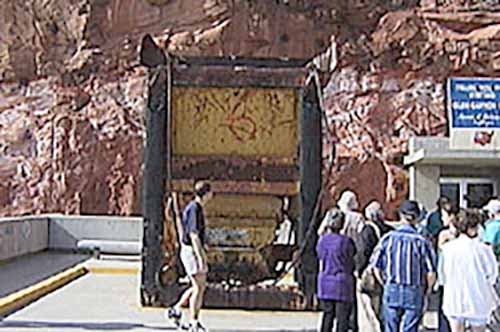
At the crest of Glen Canyon dam (location #1 on the cross-section above), we see one of a display of the cement buckets used in building the dam. The crest length of Glen Canyon Dam is 1,560 feet. The width of the roadway and sidewalks totals 35 feet. Embedded in the concrete are rails for the 165-ton traveling gantry crane. The gantry crane is used to install stoplogs and remove underwater gates for maintenance.
Short Video
 Look over the edge . . . its a long way down, more than 500 feet. We next move to the elevator on the crest of the dam. The west side elevator will descend 528 feet to a landing deep in the interior (location #2 ). The trip takes just over one minute. As you exit from the elevator, you will enter one of the dam's many galleries. The 50-degree F temperature remains constant year-round. Galleries are necessary in concrete dams for inspection purposes. In this gallery (location #3), more than 100 feet of concrete lies between you and Lake Powell.
Look over the edge . . . its a long way down, more than 500 feet. We next move to the elevator on the crest of the dam. The west side elevator will descend 528 feet to a landing deep in the interior (location #2 ). The trip takes just over one minute. As you exit from the elevator, you will enter one of the dam's many galleries. The 50-degree F temperature remains constant year-round. Galleries are necessary in concrete dams for inspection purposes. In this gallery (location #3), more than 100 feet of concrete lies between you and Lake Powell.
 As we exit the gallery, we look out over 86,000 square feet (almost two full acres) of a grassed area that lies between the dam and the power plant. The grass provides a cooling effect, much the same as an evaporative cooler, which aids in reducing temperatures inside the powerhouse.The square manholes are access points used to periodically inspect expansion joints in the penstocks, which lie 20 feet below the grass. A water trough at the base of the dam returns water to the river which seeps through the dam. This seepage is normal -- all dams seep to some extent.
As we exit the gallery, we look out over 86,000 square feet (almost two full acres) of a grassed area that lies between the dam and the power plant. The grass provides a cooling effect, much the same as an evaporative cooler, which aids in reducing temperatures inside the powerhouse.The square manholes are access points used to periodically inspect expansion joints in the penstocks, which lie 20 feet below the grass. A water trough at the base of the dam returns water to the river which seeps through the dam. This seepage is normal -- all dams seep to some extent.
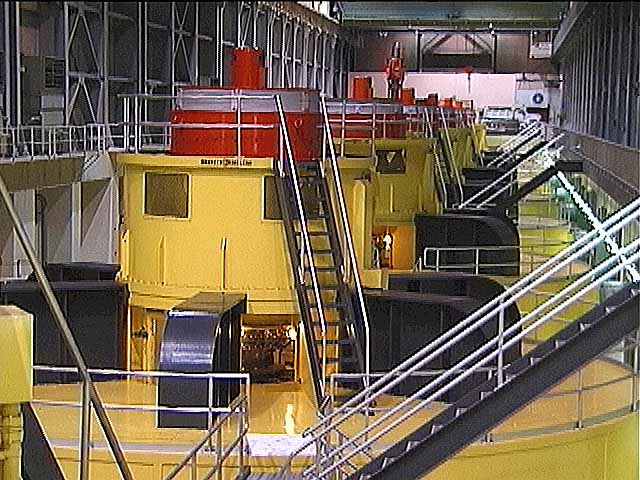
The Glen Canyon power plant has 8 electric generators that were originally installed between 1964 and 1966. The plant was upgraded during major maintenance programs during the early 1980s .The powerplant capacity is 1, 320, 000 kilowatts, or 1320 megawatts.
The generators at Glen Canyon are called hydroelectric generators because water coming from Lake Powell provides the initial energy. Water flowing in the penstock passes through a Francis-type reaction turbine before it reaches the river. As the water moves quickly through the turbine, it pushes against the blades of the turbine runner causing the runner to rotate like a pinwheel. The runner is connected by a large vertical shaft to the rotating assembly of the generator. The generator converts mechanical energy produced by the turbine into electrical energy or electricity (location #4).
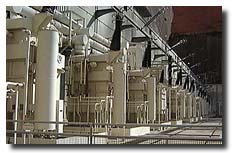 From the outside platform, you can view the massive transformers which increase the generated voltage from 13,800 volts, to 230,000 and 345,000 volts, required for transmission to distant markets. The higher voltage decreases transmission line losses.
From the outside platform, you can view the massive transformers which increase the generated voltage from 13,800 volts, to 230,000 and 345,000 volts, required for transmission to distant markets. The higher voltage decreases transmission line losses.
Each of the transformers weighs about 90 tons and includes a heavy metal core and windings surrounded by special insulating oil. The large cylindrical pipes between the power plant wall and the transformers contain the buswork connecting the generators to the transformers. The arrangement of the buswork connects each pair of generators to a bank of three single-phase transformers (location #5).
 Glen Canyon Dam
Glen Canyon Dam
The dam has two huge spillways, one on each side. These are 41 feet in diameter, and have a capacity of 104, 000 cubic feet per second each. There are 4 outlet valves connected to 8-foot outlet tubes designed to discharge water around the power plant. Water can also be released through a tunnel once used to divert water during construction of the dam.
This system was put to the test in 1983 when a late regional winter storm system increased the snow level by 200% of normal, then began to melt quickly. Lake Powell was already at a high level, so water needed to be released to make room for the heavy snow-melt. Even with the dam wide open, the lake continued to rise for weeks but was eventually controlled. Because of the high run-off that year, all the Colorado River dams released excess water causing some flooding downstream on the lower portions of the river.
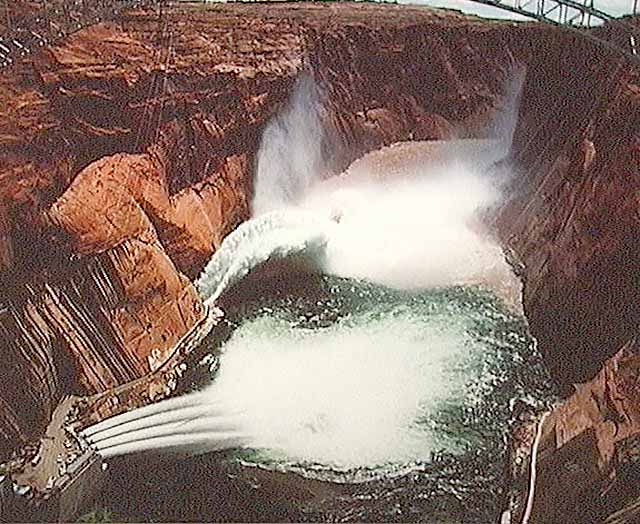
Dam with everything opened
except the east spillway,
but you can see it on the right.
Back to the Visitor Center. I will let you find the way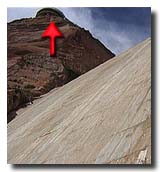
Related DesertUSA Pages
- How to Turn Your Smartphone into a Survival Tool
- 26 Tips for Surviving in the Desert
- Death by GPS
- 7 Smartphone Apps to Improve Your Camping Experience
- Maps Parks and More
- Desert Survival Skills
- How to Keep Ice Cold in the Desert
- Desert Rocks, Minerals & Geology Index
- Preparing an Emergency Survival Kit
Share this page on Facebook:
The Desert Environment
The North American Deserts
Desert Geological Terms





